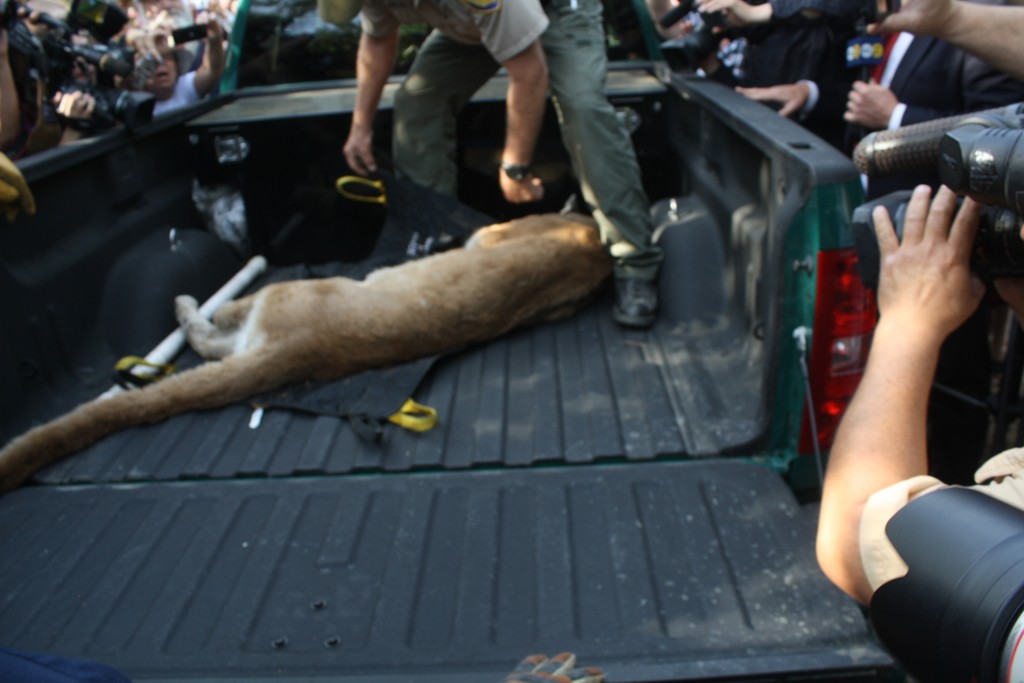
Experts say that if animals don’t return to the wild on their own, they may need to be tranquilized and transported like this mountain lion.
By Isiah REYES
Crescenta Valley has had its fair share of recent wildlife sightings that include bobcats, mountain lions and bears and there could be numerous reasons for it.
Janice Mackey, information officer for the California Dept. of Fish and Wildlife, said there is typically an increase in backyard wildlife sightings in the area during the summer because people are out and about and more daylight hours means more opportunities to spot wildlife.
“As far as the bigger game, such as bears or even mountain lions, we really don’t have any concrete research to support why there would be an increase in sightings,” Mackey said. “But a lot of it has to do with just general reporting. Social media has really increased the number of things that people are seeing now. It could be the numbers are the same but people have more opportunities to report it.”
Local residents have shared information about a bear sighting on Nextdoor, a private social network that was created for neighbors to talk online about their community. Several residents said they saw a bear on Hawkridge Drive, Hopeton Road and Edmund Avenue – all located in La Crescenta – on Thursday night before Friday trash pickup. There was not any substantial damage but residents said it was a mess to clean up.
A bear was sighted early Wednesday morning on Olive Lane in La Crescenta, again on trash day.
One common reason why larger animals make their way down to residential areas is because they are looking for food outside their normal habitat and they might smell trashcans.
“The best thing that people can do to avoid having these animals near their homes when living in areas near open space is to remove attractants,” Mackey said. “For bears, it’s garbage. All animals have a keen sense of smell. For lions, it’s removing attractants for deer because they follow the food source.”
Another reason for increased wildlife sightings could be the drought. Mackey said that Fish and Wildlife has not done any research to see if the drought could increase the levels of wildlife sightings.
“For us to say that sightings are caused by the drought is difficult for us to do without any science or data that we have,” Mackey said. “There are so many variables in each case of an animal sighting that are taken into consideration.”
Lt. Randy Tuinstra of the Los Angeles Sheriffs Dept. – Crescenta Valley Station said that there typically are more incidents in summer but sightings are consistent year round because bears come down when they see trashcans out.
“They’ll go in the trashcans for free scraps and leftovers and then they go up into the mountain again,” Tuinstra said. “That can happen year round whether it’s freezing cold or blazing hot.”
If someone spots a wildlife animal in a residential area, Tuinstra said that they should call the sheriff’s office or Fish and Game.
“We’ll have a coordinated effort to make sure everybody is safe,” Tuinstra said. “If the bear goes back to its natural habitat then we let it go. If it gets to where it’s a danger to neighborhoods, Fish and Game will take over and tranquilize it and try to [transport] it back up to the mountains.”
Mackey said the best thing to do is observe them from a safe distance.
“The first thing people need to understand is to respect wildlife at a distance, don’t run up to it and take pictures,” Mackey said. “Respect them at a distance. If you see one in distress, call animal control. Never approach them no matter how docile they may look. We only respond if it’s a public safety threat. If there’s a bear in your backyard, we want to know about it.”
There is a website designed to help people with information and resources to coexist with wildlife called Living with Wildlife Foundation (http://www.lwwf.org/). It has information on bears, mountain lions, wolves, coyotes and bobcats.
